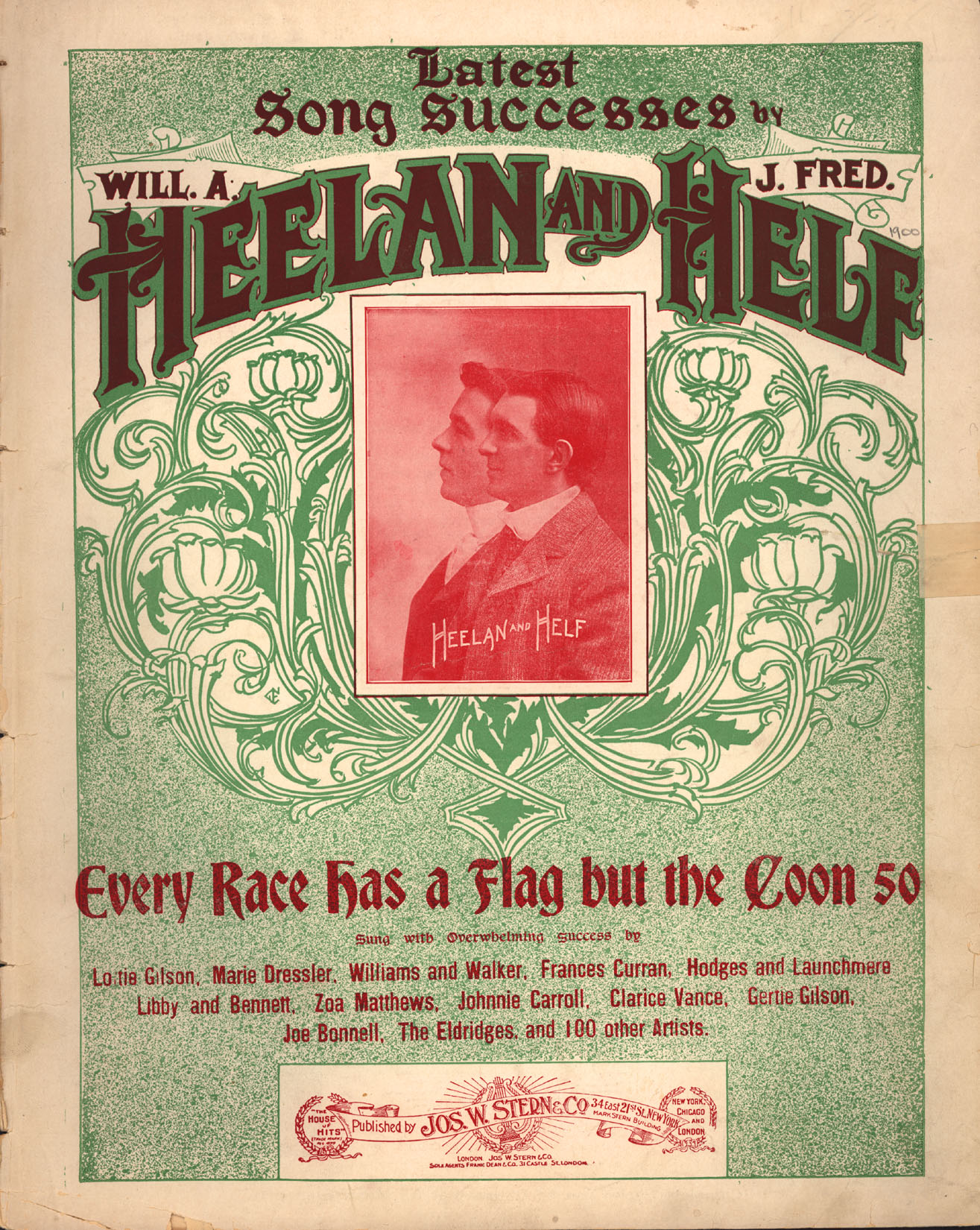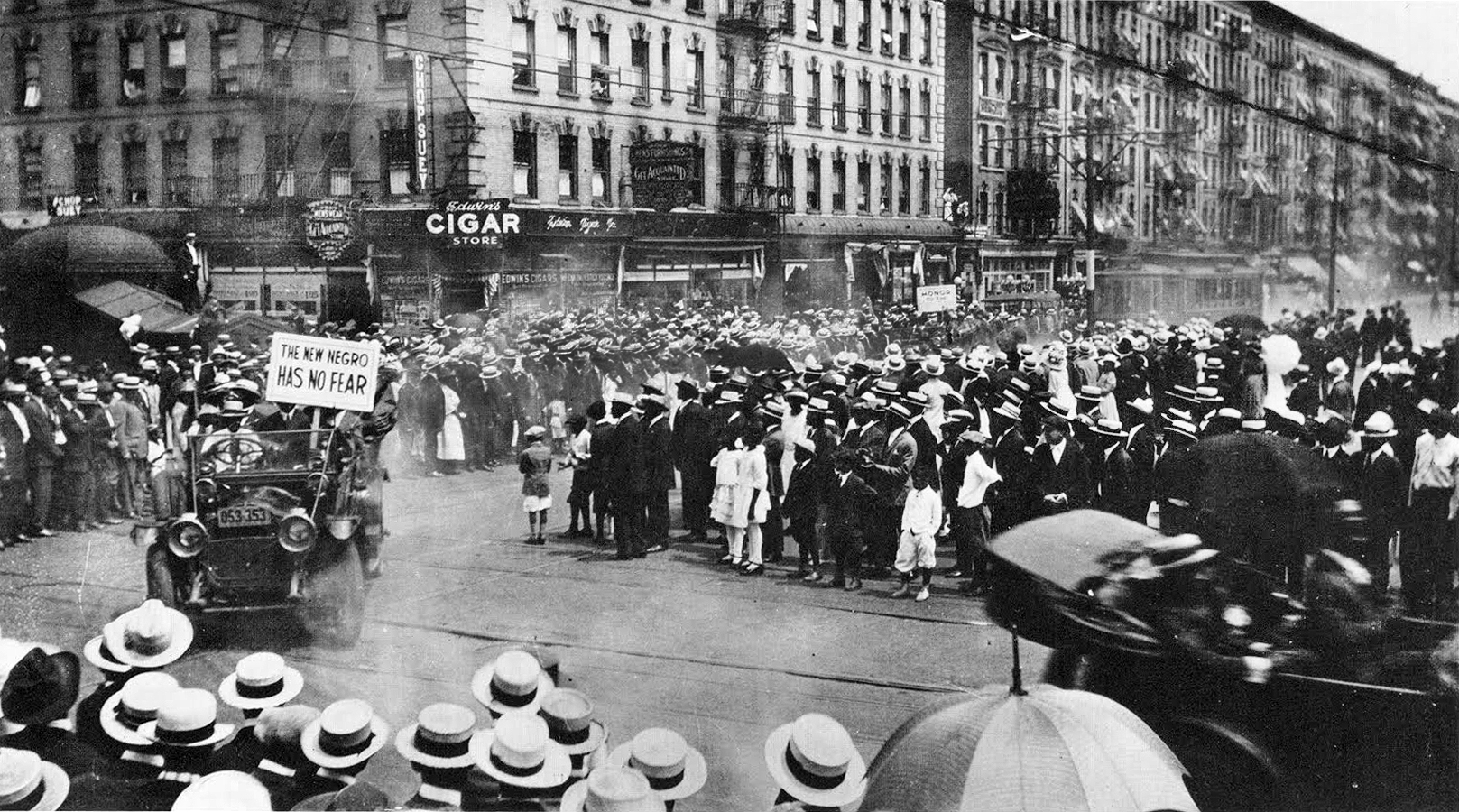|
Coon Song
Coon songs were a genre of music that presented a stereotype of black people. They were popular in the United States and Australia from around 1880 to 1920, though the earliest such songs date from minstrel shows as far back as 1848, when they were not yet identified with "coon" epithet. The genre became extremely popular, with white and black men giving performances in blackface and making recordings. Women known as coon shouters also gained popularity in the genre. Rise and fall from popularity Although the word "coon" is now regarded as racist, according to Stuart Flexner, "coon" was short for "raccoon", and it meant a frontier rustic (someone who may wear a coonskin cap) by 1832. By 1840 it also meant a Whig as the Whig Party was keen to be associated with rural white common people. At that time, "coon" was typically used to refer someone white, and a coon song referred to a Whig song. it was only in 1848 when the first clear case of using "coon" to refer to a black person ... [...More Info...] [...Related Items...] OR: [Wikipedia] [Google] [Baidu] |
Coon Coon Coon Sheet Music Cover 1901
Coon may refer to: Fauna Butterflies * Coon, common name of the butterfly ''Astictopterus jama'' * Coon, species group of the butterfly genus ''Atrophaneura'', now genus ''Losaria'' * Coon, common name of the butterfly '' Psolos fuligo'' Mammals * Coon, an alternative name for Maine Coon, a breed of domestic cat * Coon, a diminutive of raccoon People * Coon (surname) * Coön ( grc-gre, Κόων, links=no, ), a Trojan warrior who during the Trojan War wounded Agamemnon Arts and entertainment * " Coon 2: Hindsight", a 2010 episode of American animated series ''South Park'' * "The Coon", a 2009 episode of American animated series ''South Park'' * Coon Can or Conquian, a card game Slang * Coon, a racial slur, used pejoratively to refer to a dark-skinned person of African, Australian First Nations, or Pacific island heritage. * Coon Carnival, the original name for the Kaapse Klopse, a yearly minstrel festival in Cape Town, South Africa * Coon Chicken Inn, a former American ... [...More Info...] [...Related Items...] OR: [Wikipedia] [Google] [Baidu] |
Barracoon
A barracoon (a corruption of Portuguese ''barracão'', an augmentative form of the Catalan loanword ''barraca'' ('hut') through Spanish ''barracón'') is a type of barracks used historically for the internment of slaves or criminals. In the Atlantic slave trade, captured individuals were temporarily transported to and held at barracoons along the coast of West Africa, where they awaited transportation across the Atlantic Ocean. A barracoon simplified the slave trader's job of keeping the prospective slaves alive and in captivity, with the barracks being closely guarded and the captives being fed and allowed exercise. The barracoons varied in size and design, from small enclosures adjacent to the businesses of European traders to larger protected buildings. The amount of time slaves spent inside a barracoon depended primarily on two factors: their health and the availability of slave ships. Many captive slaves died in barracoons, some as a consequence of the hardships they expe ... [...More Info...] [...Related Items...] OR: [Wikipedia] [Google] [Baidu] |
Pan-African Flag
The Pan-African flag (also known as the Afro-American flag, Black Liberation flag, UNIA flag, and various other names) is a tri-color flag consisting of three equal horizontal bands of (from top down) red, black, and green. The Universal Negro Improvement Association and African Communities League (UNIA-ACL) formally adopted it on August 13, 1920, in Article 39 of the Declaration of the Rights of the Negro Peoples of the World, during its month-long convention at Madison Square Garden in New York City. Variations of the flag can and have been used in various countries and territories in the Americas to represent Garveyist ideologies. History The flag was created in 1920 by members of UNIA in response to the "coon song", a late nineteenth century craze for songs that belittle and mock African Americans and imitated of stereotyped AAVE speech, that became a hit around 1900 " Every Race Has a Flag but the Coon". This song has been cited as one of the three songs that "firmly e ... [...More Info...] [...Related Items...] OR: [Wikipedia] [Google] [Baidu] |
Universal Negro Improvement Association And African Communities League
The Universal Negro Improvement Association and African Communities League (UNIA-ACL) is a black nationalist fraternal organization founded by Marcus Garvey, a Jamaican immigrant to the United States, and Amy Ashwood Garvey. The Pan-African organization enjoyed its greatest strength in the 1920s, and was influential prior to Garvey's deportation to Jamaica in 1927. After that its prestige and influence declined, but it had a strong influence on African-American history and development. The UNIA was said to be "unquestionably, the most influential anticolonial organization in Jamaica prior to 1938," according to Honor Ford-Smith. The organization was founded to work for the advancement of people of African ancestry around the world. Its motto is "One God! One Aim! One Destiny!" and its slogan is "Africa for the Africans, at home and abroad!" The broad mission of the UNIA-ACL led to the establishment of numerous auxiliary components, among them the African Legion (a paramilitar ... [...More Info...] [...Related Items...] OR: [Wikipedia] [Google] [Baidu] |
Marcus Garvey
Marcus Mosiah Garvey Sr. (17 August 188710 June 1940) was a Jamaican political activist, publisher, journalist, entrepreneur, and orator. He was the founder and first President-General of the Universal Negro Improvement Association and African Communities League (UNIA-ACL, commonly known as UNIA), through which he declared himself Provisional President of Africa. Ideologically a black nationalist and Pan-Africanist, his ideas came to be known as Garveyism. Garvey was born into a moderately prosperous Afro-Jamaican family in Saint Ann's Bay and he was apprenticed into the print trade as a teenager. Working in Kingston, he got involved in trade unionism before he lived briefly in Costa Rica, Panama, and England. After he returned to Jamaica, he founded the UNIA in 1914. In 1916, he moved to the United States and established a UNIA branch in New York City's Harlem district. Emphasising unity between Africans and the African diaspora, he campaigned for an end to European colonial ... [...More Info...] [...Related Items...] OR: [Wikipedia] [Google] [Baidu] |
A Trip To Coontown
A Trip to Coontown is an American musical comedy. It was performed, directed, and produced by African-Americans. It was written and performed in by Bob Cole (composer), Bob Cole and Billy Johnson. and debuted it New Jersey in 1897 before touring in the U.S. and internationally. Its New York City debut was at the Third Avenue Theatre on April 4, 1898. The musical was a reworking of Cole and Johnson's skit "At Jolly Coon-ey Island" which was written by Cole for an operatic variety company called Black Patti’s Troubadours (formed by Sissieretta Jones). ''A Trip to Coontown'' spoofed the popular musical ''A Trip to Chinatown'' (1891). In the early 20th century the musical was staged in European cities. Cast According to an October 1899 advertisement in ''The Allentown Leader'', the show featured: *Coontown Sextette *Carter and Hillman's Bowery Spielers *Alice MacKay, Contralto *Freeman Sisters, acrobatic dancers *Billy Johnson, "the Luckiest Coon in Town" *Lloyd G. Gibbs, "Famous Co ... [...More Info...] [...Related Items...] OR: [Wikipedia] [Google] [Baidu] |
Bob Cole (composer)
Robert Allen Cole Jr. (July 1, 1868 – August 2, 1911) was an American composer, actor, playwright, and stage producer and director. In collaboration with Billy Johnson, he wrote and produced ''A Trip to Coontown'' (1898), the first musical entirely created and owned by black showmen. The popular song ''La Hoola Boola'' (1898) was also a result of their collaboration. Cole later partnered with brothers J. Rosamond Johnson, pianist and singer, and James Weldon Johnson, pianist, guitarist and lawyer, creating more than 200 songs. Their vaudeville act featured classical piano pieces and their musicals featured sophisticated lyrics without the usual stereotypes such as "hot-mamas" and watermelons. Success enabled Cole and Rosamond to tour America and Europe with their act. The trio's most popular songs were " Louisiana Lize" and "Under the Bamboo Tree" (1901?). Their more successful musicals were '' The Shoo-Fly Regiment'' (1906) and '' The Red Moon'' (1908, written without Weldon ... [...More Info...] [...Related Items...] OR: [Wikipedia] [Google] [Baidu] |
George W
George Walker Bush (born July 6, 1946) is an American politician who served as the 43rd president of the United States from 2001 to 2009. A member of the Republican Party, Bush family, and son of the 41st president George H. W. Bush, he previously served as the 46th governor of Texas from 1995 to 2000. While in his twenties, Bush flew warplanes in the Texas Air National Guard. After graduating from Harvard Business School in 1975, he worked in the oil industry. In 1978, Bush unsuccessfully ran for the House of Representatives. He later co-owned the Texas Rangers of Major League Baseball before he was elected governor of Texas in 1994. As governor, Bush successfully sponsored legislation for tort reform, increased education funding, set higher standards for schools, and reformed the criminal justice system. He also helped make Texas the leading producer of wind powered electricity in the nation. In the 2000 presidential election, Bush defeated Democratic incum ... [...More Info...] [...Related Items...] OR: [Wikipedia] [Google] [Baidu] |
Ragtime
Ragtime, also spelled rag-time or rag time, is a musical style that flourished from the 1890s to 1910s. Its cardinal trait is its syncopated or "ragged" rhythm. Ragtime was popularized during the early 20th century by composers such as Scott Joplin, James Scott and Joseph Lamb. Ragtime pieces (often called "rags") are typically composed for and performed on piano, though the genre has been adapted for a variety of instruments and styles. " Maple Leaf Rag", " The Entertainer", "Fig Leaf Rag", "Frog Legs Rag", and "Sensation Rag" are among the most popular songs of the genre. The genre emerged from African American communities in the Southern and Midwestern United States, evolving from folk and minstrel styles and popular dances such as the cakewalk and combining with elements of classical and march music. Ragtime significantly influenced the development of jazz. In the 1960's, the genre had began to be revived with the publication '' The All Played Ragtime'' and artists re ... [...More Info...] [...Related Items...] OR: [Wikipedia] [Google] [Baidu] |
Syncopation
In music, syncopation is a variety of rhythms played together to make a piece of music, making part or all of a tune or piece of music off-beat. More simply, syncopation is "a disturbance or interruption of the regular flow of rhythm": a "placement of rhythmic stresses or accents where they wouldn't normally occur". It is the correlation of at least two sets of time intervals. Syncopation is used in many musical styles, especially dance music. According to music producer Rick Snoman, "All dance music makes use of syncopation, and it's often a vital element that helps tie the whole track together". Syncopation can also occur when a strong harmony is simultaneous with a weak beat, for instance, when a 7th-chord is played on the second beat of measure or a dominant chord is played at the fourth beat of a measure. The latter occurs frequently in tonal cadences for 18th- and early-19th-century music and is the usual conclusion of any section. A hemiola (the equivalent Latin term ... [...More Info...] [...Related Items...] OR: [Wikipedia] [Google] [Baidu] |








